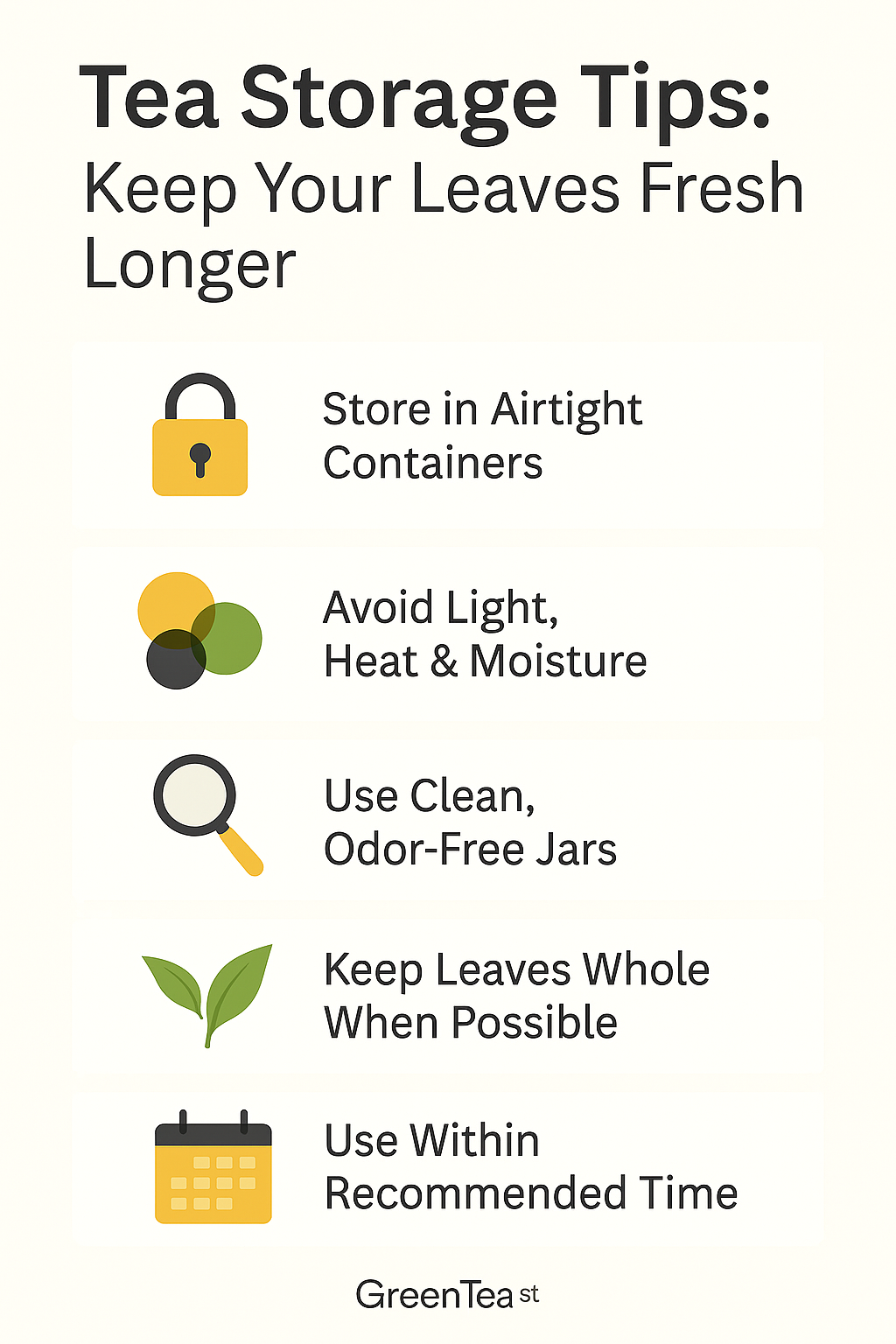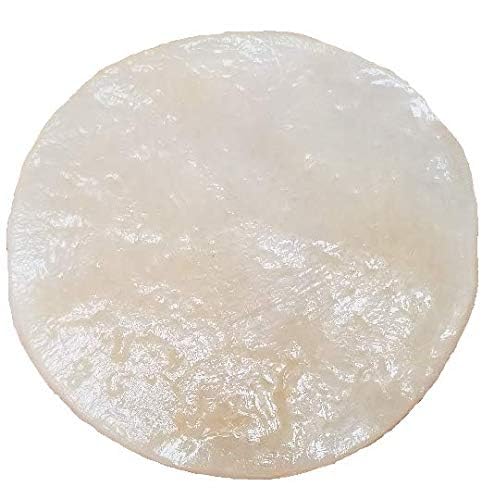How to Store Tea Properly
Good tea deserves careful handling. Whether you enjoy a fragrant cup of jasmine, a bold Assam, or a smooth Pu-erh, the way you store your tea can make all the difference. Improper storage can dull flavors, fade aromas, and shorten shelf life — even for the highest-quality leaves.
Tea is sensitive to air, moisture, heat, light, and strong odors, all of which can compromise its delicate compounds. The moment tea leaves are exposed to oxygen, they begin to oxidize, losing their signature notes and freshness. Moisture can lead to mold, while light and heat accelerate flavor breakdown. That’s why proper tea storage is as important as how you brew it.
According to research on tea quality preservation, keeping tea in airtight, opaque containers and maintaining a cool, dry environment significantly slows oxidation and nutrient loss (1).
Proper storage isn’t just about preventing spoilage — it’s about preserving what makes tea so enjoyable: the rich aroma, complex flavor, and subtle energy in every cup.
The Enemies of Tea Freshness
Even the finest tea can lose its essence if exposed to the wrong elements. Five major culprits—air, moisture, heat, light, and odors—are responsible for most tea spoilage. Understanding how they affect your tea helps you prevent early degradation and maintain peak flavor.
1. Air (Oxidation)
Once tea leaves come in contact with oxygen, oxidation begins. This process alters the leaf’s chemistry, breaking down aromatic oils and antioxidants. Over time, the tea becomes flat and lifeless. Always store your tea in an airtight container to limit oxygen exposure.
2. Moisture
Tea absorbs moisture quickly, especially in humid environments. Damp leaves can clump, lose flavor, or even develop mold. Never keep tea near the stove, sink, or refrigerator where condensation can occur.
3. Heat
Excess heat accelerates chemical breakdown, especially in delicate teas like green or white varieties. Store tea away from ovens, sunlight, and warm cabinets to preserve its essential oils and subtle notes.
4. Light
Direct sunlight or bright artificial light can fade the color of your leaves and ruin their taste. Teas should always be stored in dark, opaque containers or cabinets to protect against UV damage.
5. Odors
Tea leaves are highly absorbent. Placing tea near coffee, spices, or scented candles can make it taste off or perfumed. Keep it in a sealed tin far from strong-smelling items.
A study published in Food Chemistry confirmed that light and air exposure are the two leading factors that degrade tea’s antioxidants and flavor compounds over time (2).
General Storage Guidelines for All Teas
No matter what type of tea you drink, proper storage follows a few universal rules. These simple habits protect your tea’s freshness, aroma, and nutritional value for months—or even years—after purchase.
1. Use Airtight Containers
Tea leaves are hygroscopic, meaning they easily absorb moisture and odors from the environment. Use airtight containers made from tin, ceramic, or dark glass to protect against humidity and smells. Avoid plastic containers, which can transfer unwanted flavors.
2. Keep Tea Cool, Dry, and Dark
Temperature stability is crucial. Store tea away from heat sources like ovens, windows, and stoves. A cool, dry cupboard or pantry is ideal. Avoid the refrigerator unless it’s vacuum-sealed—otherwise condensation can ruin the leaves when brought back to room temperature.
3. Limit Air Exposure
Every time you open a tea tin, a bit of oxygen enters. Instead of large containers, divide tea into smaller tins if you drink it slowly. This minimizes oxidation and helps retain aroma.
4. Avoid Clear Containers
Although glass jars look appealing, light exposure can damage delicate leaves. If you prefer to display your teas, use tinted glass or keep them inside closed cabinets.
5. Label and Rotate Stock
Mark each tea with its purchase or opening date, and rotate your collection—oldest first. This ensures you enjoy each tea before it loses flavor or potency.
According to storage studies on polyphenol retention, tea kept in opaque, airtight containers at stable room temperature preserves its flavor compounds and antioxidants far better than tea stored in open or transparent containers (3).
How to Store Different Types of Tea
Each tea variety has its own character and level of sensitivity. While the basic principles remain the same—avoid air, light, moisture, and heat—the degree of protection required varies depending on how oxidized or fermented the tea is.
Below are the best storage methods for the most popular teas:
1. Green Tea
Green tea is the most delicate of all teas. Since it undergoes minimal oxidation, it’s extremely sensitive to light, heat, and air exposure. Store it in airtight, opaque tins in a cool, dry, and dark place. For long-term storage, vacuum sealing or refrigeration (inside a moisture-proof bag) can help preserve freshness.
If refrigerated, allow it to reach room temperature before opening to prevent condensation. Japanese greens like Sencha and Gyokuro especially benefit from these precautions.
Research shows that improper storage at high temperatures significantly reduces chlorophyll and catechin content in green tea, lowering both taste and antioxidant value (4).
2. Black Tea
Black tea is fully oxidized, making it more stable than green or white tea. However, it’s still vulnerable to air and odors. Keep it in airtight metal tins or dark glass jars, away from strong-smelling foods or spices.
Black tea’s bold flavor can last up to two years if stored correctly at room temperature. Avoid plastic bags or paper boxes once opened—they let in air and moisture.
According to packaging studies, black teas stored in sealed tins retain their aroma and flavor oils longer than those kept in standard cardboard boxes (5).
3. Oolong Tea
Oolong teas sit between green and black tea in oxidation, meaning their storage needs depend on how light or dark they are. Light oolongs (like Tieguanyin) should be kept in airtight, lightproof containers in a cool spot, while dark oolongs can be stored a bit more casually in sealed tins.
Avoid refrigeration unless the package is vacuum-sealed—temperature swings can damage flavor.
Fresh, floral oolongs can lose aroma within months if not stored correctly, while roasted oolongs can improve slightly with time when kept dry and sealed.
4. White Tea
White tea is only lightly processed, making it delicate like green tea but slightly more forgiving. It should be stored in airtight tins or foil-lined bags that protect it from moisture and light. A cool, dark cabinet is ideal.
If you plan to keep it long-term, avoid humid areas like kitchens or bathrooms. Some aged white teas—such as Shou Mei or Bai Mu Dan—can develop richer flavors over time when stored in a dry, stable environment.
A study published in the Journal of Food Science and Technology found that cool, low-humidity storage helps white tea maintain its polyphenols and subtle floral aroma longer (6).
5. Pu-erh Tea
Pu-erh is unique because it’s a fermented and aged tea, meaning it actually benefits from airflow—but only the right kind. Unlike other teas, Pu-erh should not be stored in airtight containers. Instead, keep it in breathable wrapping, such as unglazed clay jars or paper packages, that allow slow fermentation to continue.
The ideal storage conditions are cool, dry, and well-ventilated, with stable humidity around 60–70%. Avoid direct sunlight or strong odors. Over several years, Pu-erh develops deeper flavor and aroma—a process prized by collectors.
Long-term studies on microbial aging show that Pu-erh’s antioxidant activity increases during proper storage due to ongoing fermentation (7).
6. Herbal and Floral Teas
Herbal teas—like chamomile, peppermint, and hibiscus—contain essential oils that degrade quickly when exposed to light and air. Store them in dark, airtight containers away from sunlight, moisture, and heat.
Because most herbal teas lack preservatives, it’s best to consume them within 6–12 months of opening. Labeling jars with purchase dates helps track freshness.
Floral teas (like rose or lavender) can fade in color and aroma if kept near spices or strong-smelling products, so always separate them in storage.
How Long Tea Lasts (Shelf Life Table)

The shelf life of tea depends on how it’s processed, stored, and packaged. In general, teas with higher oxidation (like black and dark oolong) stay fresh longer, while lighter teas (like green or white) lose flavor faster. Proper storage can extend freshness well beyond these averages.
Here’s a quick guide:
| Tea Type | Average Shelf Life (Unopened) | Shelf Life After Opening | Best Storage Conditions | Signs of Expiry |
|---|---|---|---|---|
| Green Tea | 12–18 months | 6–8 months | Airtight tin, cool & dark place; refrigerate if needed | Dull color, grassy or stale smell |
| White Tea | 18–24 months | 8–12 months | Airtight, cool & dry; away from sunlight | Loss of aroma, yellowing leaves |
| Oolong Tea | 24–36 months | 12–18 months | Sealed tin, room temp, away from moisture | Flat taste, reduced floral scent |
| Black Tea | 24–36 months | 12–24 months | Airtight container; pantry storage | Bitter or cardboard-like flavor |
| Pu-erh Tea (Raw) | Ages indefinitely (improves) | Same | Breathable wrap; cool & ventilated environment | Mold spots (improper humidity) |
| Pu-erh Tea (Ripe) | 10+ years | Same | Clay jar or paper wrap; steady humidity | Sour odor or visible mold |
| Herbal/Floral Teas | 12–18 months | 6–12 months | Dark, airtight glass or tin | Faded color, weak aroma |
| Matcha Powder | 6–12 months | 1–3 months | Airtight tin; refrigerate after opening | Clumping, dull green hue |
When stored in opaque, airtight containers under stable temperatures, teas retain much of their aroma, polyphenols, and flavor well past their nominal expiry date.
A controlled study confirmed that proper sealing and darkness significantly slow down oxidation in tea catechins, preserving taste and antioxidant potency (8).
FAQs About Storing Tea Properly
Tea doesn’t spoil like food, but it loses its freshness, aroma, and nutritional value over time. Green and white teas fade faster, while black and pu-erh teas age more gracefully when stored well.
Keep it in an airtight, opaque container made of tin, ceramic, or dark glass. Place it in a cool, dry, and dark place away from direct sunlight and humidity.
It’s generally not recommended. Moisture condensation can ruin the leaves when taken in and out of the fridge. Only refrigerate vacuum-sealed teas meant for long-term storage.
Most teas stay fresh for 6 months to 3 years depending on the type. Green and white teas last about a year, while oolong, black, and pu-erh teas can retain flavor longer if stored properly.
If it’s resealable and airtight, yes. Otherwise, transfer it to a sealed, non-transparent container to protect it from air and light exposure.
Leaving it in clear glass containers or open packets on the kitchen counter. Light, air, and heat are the top enemies of tea freshness.
Conclusion
Good tea deserves good care. Proper storage not only maintains flavor but also protects the natural oils, antioxidants, and aroma that make tea special. The golden rule is simple: keep tea away from air, light, heat, and moisture.
Use airtight tins, store in a dark cupboard, and avoid the fridge unless absolutely necessary. When you open a fresh batch and catch that crisp aroma, you’ll taste the difference that good storage makes.
Whether you enjoy a calming green, a bold black, or a floral oolong, preserving its quality ensures every cup feels just as satisfying as the first.


